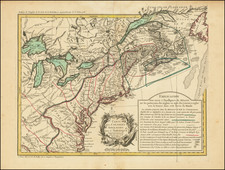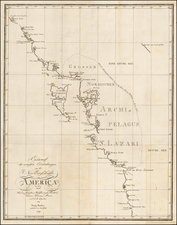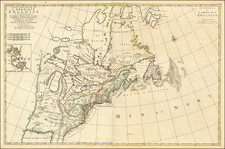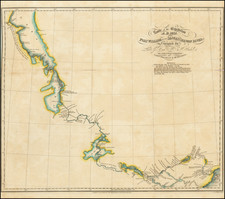Striking View of the Battle of Signal Hill, the Final Battle of the French & Indian War in North America
Fine optical view showing the French capture of St. John's, Newfoundland in September 1762, drawn by Andre Basset. The view is very dramatic, with hundreds of soldiers on the move. Artillery is firing from the beach onto landing craft approaching shore. Large ships return fire in the harbor.
The French & Indian War in North America
The French & Indian War was the world's first global war, with campaigns fought in India, North America, South America, West Africa, and Europe. In Europe, the fighting had much to do with Prussian aggression in Central Europe, which raised the hackles of the Austro-Hungarian Empire. In North America, the fight centered on disputed outposts in the Ohio River Valley. Hostilities began when British colonial militia, under the command of George Washington, ambushed a contingent of French soldiers near Fort Duquesne, or what is now Pittsburgh, Pennsylvania. Washington and his men killed ten, including the French commander, Jumonville, leading the French to retaliate by attacking Washington at Fort Necessity on July 3, 1754. Washington surrendered and the French & Indian War was on.
Both Britain and France sent troops to defend their claims. The French, calling on relations with local indigenous tribes, made early gains. By 1758, the British were striking back; they took Louisbourg and captured Fort Duquesne. On Prince Edward Island, then known as Ile Saint-Jean, and elsewhere the British deported the Acadian population. However, the French then gained ground by winning the Battle of Ticonderoga (1758).
1759, however, was Britain's year. In what became known as the Annus Mirabilis, they made major gains on every front of this world war. In North America, they took Forts Niagara and Ticonderoga, besieged Quebec and defeated the French on the Plains of Abraham. On September 8, the French also surrendered Montreal. These defeats brought the Seven Nations of Canada, France's allies, to the negotiating table and they ceased their involvement with the Treaty of Kahnawake.
The Battle of Signal Hill
The battle references, therefore, was France's last attempt to strike a blow in their favor. In order to strengthen their hand at the peace negotiations and to gain access to the Newfoundland fisheries, French troops decided to take St. John's, Newfoundland. A small squadron commanded by the Chevalier de Ternay slipped past the British blockade at Brest and crossed the Atlantic in May and June 1762.
On June 27 of that year, Ternay had successfully navigated his ships to Newfoundland. The Comte d'Haussonville led a force of 760 French and 161 Irish soldiers to occupy St. John's. As the caption mentions the French 'descent' on St. John's, it is likely this moment shown in the image, although the precise event it references is unclear. In the following weeks d'Haussonville extended French control over much of the island. Victory was short-lived, however. On September 13, Colonel William Amherst landed 1,559 soldiers to the north of Signal Hill, where the French had consolidated their artillery.
On September 15, 1762, Royal Navy warships aimed their broadsides at Signal Hill while 200 British troops climbed the cliffs. They took the 292 French infantry by surprise and quickly forced them into the neighboring fort. Ternay escaped under cover of fog with his ships, leaving d'Haussonville behind. After artillery exchange, the garrison surrendered on September 18. Newfoundland was to stay in British hands until Canada became independent in 1867.
This view was engraved by Andrew Basset, an engraver-publisher who specialized in broadsides and other ephemera. This image is labeled as showing the 'descent' of the French on St. John's most commonly associated with the Battle of Signal Hill and depicts an important moment at the end of the first global war.










![Carta rappresentante una parte della Baja Hudson, e le Regioni a Maestro dell'America Settentrle. [Map representing a part of Hudson Bay, and the regions to the northwest of North America.]](https://storage.googleapis.com/raremaps/img/small/95989.jpg)



